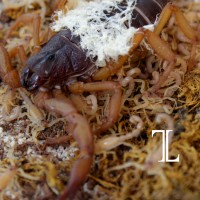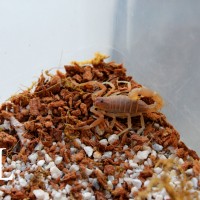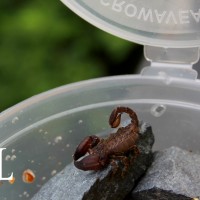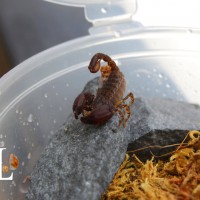Search results
-

Scorpion mating
First of all, make sure they are all adults and put a flatrock so that the male can deposit his spermatophore.- Arachnotroik
- Post #2
- Forum: Scorpions
-

Comment by 'Arachnotroik' in media 'L. quinquestriatus 5i'
@PelesAsher Thank you!- Arachnotroik
- Gallery comment
-

-

-

-

P. villosus "Oranje morph" 2i scorplings w/ 8i mother
- Arachnotroik
- Media item
- Comments: 1
- Category: Buthidae
-

P. Granulatus 4i
- Arachnotroik
- Media item
- Comments: 0
- Category: Buthidae
-

Centruroides gracilis care
I feed mine once-twice a week depending on it's instar. I feed 4th Instar specimens below twice theb i feed the 5th instar and above specimens once. The specimen that i have right now are currently in their 7th Instar, both of them are about an Inch and a half, But i did see some specimens that...- Arachnotroik
- Post #13
- Forum: Scorpions
-

Centruroides gracilis care
Yes, just make sure to put a bark or anything he/she can hang on.- Arachnotroik
- Post #5
- Forum: Scorpions
-

AFS Flowers
These guys will re-scape everything, even after all the hardwork you gave just to make his/her enclosure beautiful, Lol.- Arachnotroik
- Post #9
- Forum: Scorpions
-

P. Transvaalicus, A. Crassicauda, and A. Bicolor
Parabuthus transvaalicus are fairly big for a desert type and i think they are the 2nd largest buthid in the world, behind Parabuthus villosus. Regarding with the best feeding response, I'd still vote for Parabuthus transvaalicus though all of them has a good feeding response which is why i love...- Arachnotroik
- Post #2
- Forum: Scorpions
-

Centruroides gracilis care
Yes, majority of what u said is correct. Regarding on how humid does it have to be, i think spraying once a week is enough and i'd put a shallow waterdish too. I feed mine once a week. About their size, males are usually longer, their size are a bit close to Heteroctonus junceus.- Arachnotroik
- Post #2
- Forum: Scorpions
-

Comment by 'Arachnotroik' in media 'C. celebensis 6i-7i'
@RezonantVoid In my country, and other southeast asian countries, they can be caught in the wild. They are usually seen inside dead tree trunks. So, i think we can say that they are scrape dwellers.- Arachnotroik
- Gallery comment
-

Comment by 'Arachnotroik' in media 'C. celebensis 6i-7i'
@RezonantVoid Yeah, i once have some of those Lychas sp, i think it's Lychas marmoreus? The body does looks the same with the Urodacus sps. But this guys are small, i mean freaking small. They're not even an inch.- Arachnotroik
- Gallery comment
-

-

-

Scorpion burying prey?
He's big, might be from 6th-7th instar.Oh, and the burying of the things he spits? it's normal. My male 8i H. swammerdami does it all the time, I though he's just a clean eater, But no. One day I went for a substrate change, and wow loads of things are burried in the substrate.- Arachnotroik
- Post #4
- Forum: Scorpions
-

Scorpion burying prey?
It's normal for them to not eat for some weeks or even a month. How big is it anyway? Instar rather. From my experience Pandinus & Heterometrus species are not good show eaters, specially when they are in their sling - juvenile stage. But when they reach their adulthood? they are monsters.- Arachnotroik
- Post #2
- Forum: Scorpions
-

-

Comment by 'Arachnotroik' in media 'Freshly molted T. smithii 8i male'
@Falsielove13 i just based off it's chela since it's very bulbous, but im not really that sure since barks are not really my thing. Saw yours, kinda looks like a male too. But again, i'm not really that sure.- Arachnotroik
- Gallery comment
